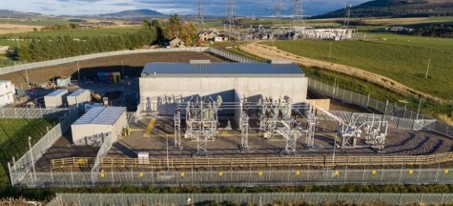Synchronous condenser (SC) technology and Battery Energy Storage Systems (BESS) complement each other in a hybrid configuration. This provides a range of grid-supporting functions, including black-start capability. Christian Payerl, Synchronous Condensers Expert, ABB explains.
The decline in system inertia is creating a major challenge for the world’s electric power grids. It results from the decommissioning of traditional large-scale, centralized power plant that is based largely on rotating synchronous generators. This decline is being accelerated by increased power demand and penetration of inverter-based generation from renewable resources such as wind and solar.
It is well known that reduced system inertia leads to lower grid stability and decreased grid resilience. However, it is often not appreciated that the removal of synchronous generators also causes a decrease in the available fault current, with a consequent impact on existing relay protection systems.
The Increased penetration of renewables also affects grid stability by potentially introducing new phenomena such as oscillations. They can also have a negative impact on power quality.
There is considerable R&D activity focused on new algorithms and control schemes to avoid grid stability problems. However, a hybrid approach based on existing, well-proven technology uses an SC for fault current contribution and real inertia together a BESS for active power and frequency support.
SC in combination with grid-following or grid-forming inverters

Grid-following inverter technology is older, well established and common in new installations, especially at a smaller scale. It relies on a stable grid. Too much variation of the voltage phasor can cause control problems for the inverter. The main drawback is that this type of inverter cannot connect to an unstable grid or be used for a black-start.
In comparison, grid-forming inverters are relatively new and less common but are being deployed in larger scale BESS installations. This inverter type can stabilize a grid and provide black-start capability.
A particular challenge of inverter-based technologies is that they can cause problems such as power oscillations and opposing control due to the digital nature of their control and measurement systems.
In contrast, the operation of the SC is determined by simple physics. This makes the SC a stable and reliable resource for grid support.
A combination of power electronics and SCs is the best solution for multiple applications:
Voltage and reactive power control
The SC adds high overload capability through its inherent properties as a physical rotating machine. It provides instantaneous support during a fault, lifting the voltage and reducing the impact of voltage dip.
After clearing the fault, the SC can create a slight overvoltage as it cannot act quickly to reduce the excitation current. In this case, the quick absorption of reactive power from a power electronic device such as a BESS or STATCOM can reduce this over-swing in voltage, so the system voltage will have a faster return to its steady state.
Inertia and frequency control
Inertia and frequency control is supplied as real inertia by the SC, complemented by fast frequency control, sometimes called “virtual” inertia, by the BESS. The hybrid system has been shown to give better system performance and lower rate of change of frequency (ROCOF).
Short circuit capacity
Short circuit capacity (short circuit ratio – SCR) is an important aspect of the power grid and its relay protection functions. An SC can provide very high short-circuit currents of several times the rated current. Combining the SC with a BESS can therefore provide a large fault current contribution without the need to over-dimension the BESS inverter to handle the large current that occurs in fault scenarios.
Black-start capability
Black-start capability is provided by the BESS grid-forming inverter. This first establishes the local grid to which the SC is synchronized. The SC then adds fault current capability and voltage and frequency stability as the larger grid is restarted and built up by adding additional power generation and loads.
Oscillation damping
Oscillation damping can be improved by having an SC connected to the grid in combination with BESS units or by adding a power oscillation damping function (POD) as part of the SC’s automatic voltage regulator (AVR) system.
Time to work together
Combining an SC and BESS offers clear benefits in providing grid-supporting functions. Together they can stabilize the grid through increased short-circuit current, increased frequency support and system inertia, decreasing ROCOF, and reactive power control. Furthermore, the combined system can provide black-start capability.

